阻燃性环氧树脂灌封胶
阻燃环氧树脂胶黏剂配方分析
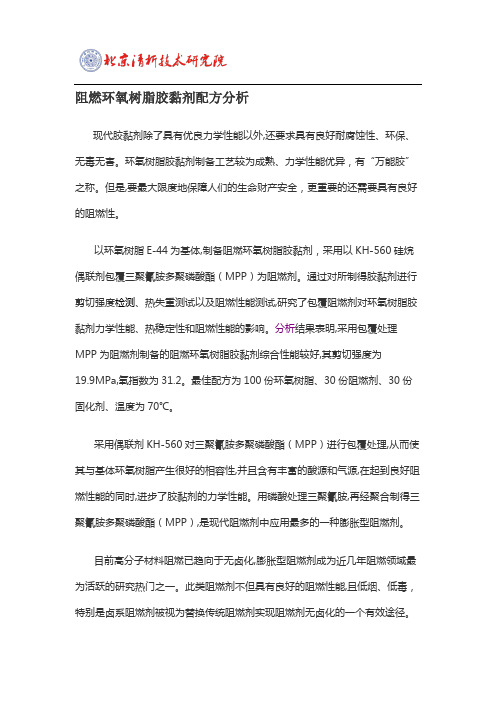
阻燃环氧树脂胶黏剂配方分析现代胶黏剂除了具有优良力学性能以外,还要求具有良好耐腐蚀性、环保、无毒无害。
环氧树脂胶黏剂制备工艺较为成熟、力学性能优异,有“万能胶”之称。
但是,要最大限度地保障人们的生命财产安全,更重要的还需要具有良好的阻燃性。
以环氧树脂E-44为基体,制备阻燃环氧树脂胶黏剂,采用以KH-560硅烷偶联剂包覆三聚氰胺多聚磷酸酯(MPP)为阻燃剂。
通过对所制得胶黏剂进行剪切强度检测、热失重测试以及阻燃性能测试,研究了包覆阻燃剂对环氧树脂胶黏剂力学性能、热稳定性和阻燃性能的影响。
分析结果表明,采用包覆处理MPP为阻燃剂制备的阻燃环氧树脂胶黏剂综合性能较好,其剪切强度为19.9MPa,氧指数为31.2。
最佳配方为100份环氧树脂、30份阻燃剂、30份固化剂、温度为70℃。
采用偶联剂KH-560对三聚氰胺多聚磷酸酯(MPP)进行包覆处理,从而使其与基体环氧树脂产生很好的相容性,并且含有丰富的酸源和气源,在起到良好阻燃性能的同时,进步了胶黏剂的力学性能。
用磷酸处理三聚氰胺,再经聚合制得三聚氰胺多聚磷酸酯(MPP),是现代阻燃剂中应用最多的一种膨胀型阻燃剂。
目前高分子材料阻燃已趋向于无卤化,膨胀型阻燃剂成为近几年阻燃领域最为活跃的研究热门之一。
此类阻燃剂不但具有良好的阻燃性能,且低烟、低毒,特别是卤系阻燃剂被视为替换传统阻燃剂实现阻燃剂无卤化的一个有效途径。
北京清析技术研究院在华北、华南、华中、华东、西北等地区,建立12大分院及配套实验室,秉承母校校训,以严谨、求实的工作态度,为数千家企业客户提供产品研发、成分分析、材料检测、工业诊断、模拟测试、大型仪器测试、可靠性验证等专业技术服务,还为全国范围内的公安局、法院、检察院、律师事务所、司法鉴定中心、医院、高等院校、中国科学院提供专业技术服务。
经过几十年的团队技术积累,北京清析技术研究院下设环境检测事业部、食品保健品检测事业部、药品化妆品检测事业部、失效分析事业部、公检法服务事业部、高校科研服务事业部、成分分析/配方分析事业部、生物医药事业部等10大部门。
环氧树脂灌封胶资料

环氧树脂灌封胶资料
环氧树脂灌封胶是一种灌封树脂,它由多种有机物,如颗粒,炭黑,
氧化亚铁,二氧化硅,纤维素,和环氧树脂,组成。
它具有优良的抗老化
性和抗渗漏性能,可以有效地保护管道和阀门免受阳光,水,污染物等的
侵蚀,以及延长其使用寿命。
环氧树脂灌封胶的使用方法是:1.根据实际需要,将所需环氧树脂灌
封胶加入容器中,并在其中加入所需的干燥剂,如氧化亚铁,炭黑和二氧
化硅等;2.将混合剂按照技术要求,分别涂抹于受保护的部位,如阀门口,管道拐弯处等,并根据需要将颗粒细小的纤维素加入混料中,以增强灌封
效果;3.将混合物以滚涂,涂抹或喷涂的方式覆盖受保护的部位,并在室
温下施加正常的压力。
环氧树脂灌封胶操作规程

罐胶操作规程
一、使用前准备
1.产品罐胶部分必须密封,防止胶体渗漏到电器部分;
2.产品引线可用扎带或皮筋扎好,排布规范整齐;
3.需要浇封的产品摆放必须与地面垂直,可用水平尺测试垂直度,以保证胶体浇灌均匀不会单边溢出。
二、使用方法
在环境清洁的场所进行操作,操作过程分为三个步骤:配比→浇灌→固化
清洗: 阻燃环氧胶与固化剂(重量4:1,体积2.75:1)比例配置。
涂抹: 可用一次性杯做容器,两种液体必须搅拌均匀后才可以浇灌。
固化:浇灌完成后放入高温箱固化,固化时间60°c / 4小时
70°c/ 3小时。
三、注意事项
1.使用该产品时应配戴胶皮防护手套,用完后注意密封存放在阴凉干燥处;
2.阻燃环氧胶气温高时间长会有少量沉淀,使用前搅拌均匀即
可。
3.高温情况下容易损坏的元器件(如:电池组)不要放入高温箱固化,放在常温下固化即可。
常州市佐安电器有限公司
质检部
2012年4月1日。
环氧树脂灌封胶技术指导书
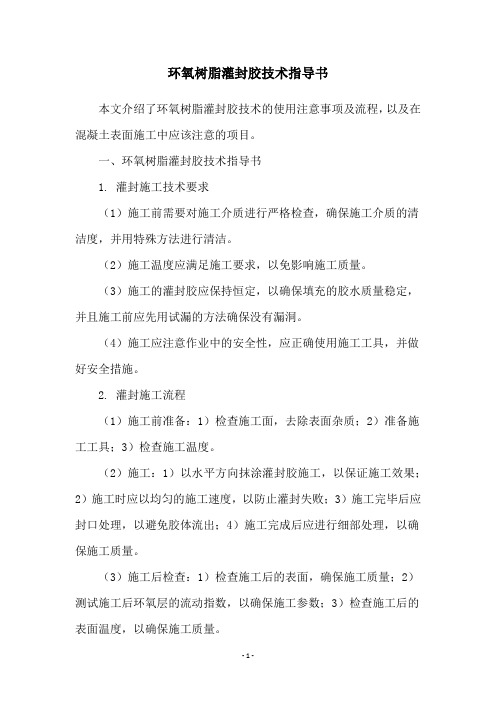
环氧树脂灌封胶技术指导书
本文介绍了环氧树脂灌封胶技术的使用注意事项及流程,以及在混凝土表面施工中应该注意的项目。
一、环氧树脂灌封胶技术指导书
1. 灌封施工技术要求
(1)施工前需要对施工介质进行严格检查,确保施工介质的清洁度,并用特殊方法进行清洁。
(2)施工温度应满足施工要求,以免影响施工质量。
(3)施工的灌封胶应保持恒定,以确保填充的胶水质量稳定,并且施工前应先用试漏的方法确保没有漏洞。
(4)施工应注意作业中的安全性,应正确使用施工工具,并做好安全措施。
2. 灌封施工流程
(1)施工前准备:1)检查施工面,去除表面杂质;2)准备施工工具;3)检查施工温度。
(2)施工:1)以水平方向抹涂灌封胶施工,以保证施工效果;2)施工时应以均匀的施工速度,以防止灌封失败;3)施工完毕后应封口处理,以避免胶体流出;4)施工完成后应进行细部处理,以确保施工质量。
(3)施工后检查:1)检查施工后的表面,确保施工质量;2)测试施工后环氧层的流动指数,以确保施工参数;3)检查施工后的表面温度,以确保施工质量。
三、在混凝土表面施工时应注意的事项
(1)混凝土表面应干燥;
(2)有轻微裂缝的应做好补强;
(3)施工前应作好清洁处理;
(4)使用施工工具时应注意安全卫生;
(5)施工时应控制施工温度;
(6)注意施工方法和施工顺序;
(7)完成后应注意保护,使施工结果有较长时间的保护效果。
环氧树脂胶水专用无卤阻燃剂

成企鑫环氧树脂胶水专用无卤阻燃剂产品说明书
本品无卤阻燃剂是以N、P为主要阻燃元素的膨胀型环保阻燃剂,完全符合欧盟RoHS指令和REACH 法规要求。
在环氧胶中应用具有分散性、稳定性好,阻燃效果好等特点。
本产品符合目前行业对阻燃材料的无卤化、低烟无毒的要求,是适用于环氧胶中的良好阻燃剂。
二、性能指标
三、使用建议
在环氧胶体系中建议添加15%-20%,具有较好的阻燃效果。
四、注意事项
1.因体系中胶固含量不同、制品厚度不同,阻燃剂添加量可作适当调整。
2.环氧胶体系中加阻燃剂后长时间静置,阻燃剂会出现沉降,使用前搅拌均匀即可。
五、储存与包装
储存于干燥、常温环境中,严防受潮、受热。
25kg/袋,纸塑+内衬+铝箔包装。
E031灌封胶(AB料) 说明书
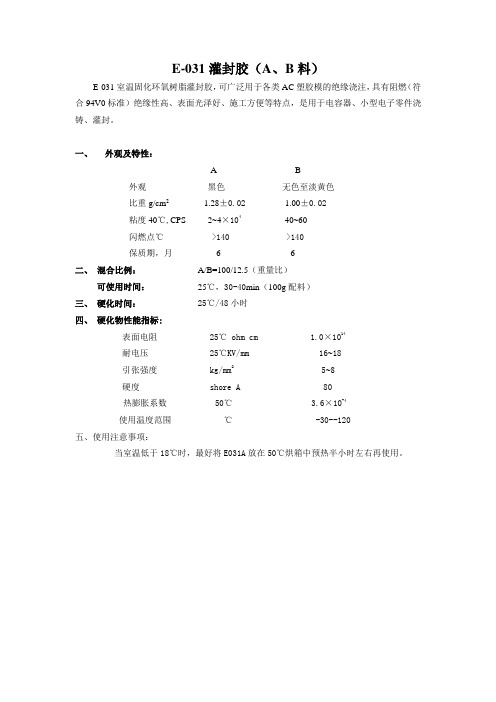
E-031灌封胶(A、B料)
E-031室温固化环氧树脂灌封胶,可广泛用于各类AC塑胶模的绝缘浇注,具有阻燃(符合94V0标准)绝缘性高、表面光泽好、施工方便等特点,是用于电容器、小型电子零件浇铸、灌封。
一、外观及特性:
A B
外观黑色无色至淡黄色
比重g/cm2 1.28±0.02 1.00±0.02
粘度40℃,CPS 2~4×10440~60
闪燃点℃ >140 >140
保质期,月 6 6
二、混合比例:A/B=100/12.5(重量比)
可使用时间:25℃,30-40min(100g配料)
三、硬化时间: 25℃/48小时
四、硬化物性能指标:
表面电阻 25℃ ohm cm 1.0×1014
耐电压 25℃KV/mm 16~18
引张强度 kg/mm2 5~8
硬度 shore A 80
热膨胀系数 50℃ 3.6×10-4
使用温度范围℃-30--120
五、使用注意事项:
当室温低于18℃时,最好将E031A放在50℃烘箱中预热半小时左右再使用。
环氧树脂灌封胶的6个使用步骤,你都记熟了吗?如何选购?

环氧树脂灌封胶的6个使用步骤,你都记熟了吗?如何选购?很多新人由于刚入行或者是之前没有用过环氧树脂灌封胶,缺乏经验,所以不知道该如何下手。
其实,环氧树脂灌封胶操作起来也不难,只需要记住这下面的6个步骤,保管你操作起来得心应手!赶快随着我一起往下看!一、环氧树脂灌封胶使用步骤详解第①步:在操作之前,要将被粘接物表面的油污、灰尘、水等杂物清理干净,保持被粘接基材表面的干燥和清洁。
第②步:因为环氧树脂灌封胶是需要调配的,所以我们在调配之前先检查一下A胶是否符合要求,有没有沉降物,并且将A胶充分搅拌均匀,如果搅拌的不均匀很容易导致有的地方固化了,而有的地方还没有固化。
第③步:环氧树脂灌封胶的包装上有配比使用说明,所以我们要按配比取量,请一定要记住配比是重量比而非体积比,A、B剂混合后需充分搅拌均匀,以避免固化不完全。
第④步:检查搅拌均匀后要在固化前及时灌胶,并且在使用时间内将已经配比搅拌均匀的灌封胶使用完,切记不要将开封的灌封胶放在下次使用,很影响灌封胶的使用效果。
第⑤步:灌封时要将产品的缝隙填满,所以如果没有填满,那么我们有必要进行二次灌封。
第⑥步:固化的过程中,要清理固化的环境,保持操作环境的干净。
不要让灰尘、油污等掉进胶水中。
二、环氧树脂灌封胶选购选购环氧树脂灌封胶,首先提到的便是灌封胶的品牌,品质好、售后好、出货快是衡量品牌好坏的标注之一。
其次我们在选择环氧树脂灌封胶的时候,最好是结合自己的产品需求去选择,不一定大品牌的就适合你,应该综合考虑,货比三家,总没错的,不过也不要贪小便宜,还是需要选择质量有保障的环氧树脂灌封胶,更放心。
以上便是环氧树脂灌封胶的使用过程,每一步都清晰明朗,我们在施胶的过程中要严格按照步骤来操作,在配比胶水的时候要搅拌均匀,基材的表面要清洁、干燥,这样才能保障环氧树脂灌封胶的使用效果!。
电子灌封胶分类和用途
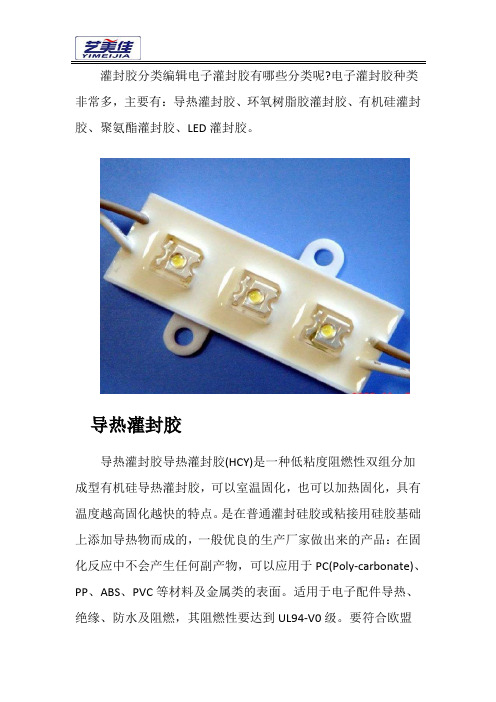
灌封胶分类编辑电子灌封胶有哪些分类呢?电子灌封胶种类非常多,主要有:导热灌封胶、环氧树脂胶灌封胶、有机硅灌封胶、聚氨酯灌封胶、LED灌封胶。
导热灌封胶导热灌封胶导热灌封胶(HCY)是一种低粘度阻燃性双组分加成型有机硅导热灌封胶,可以室温固化,也可以加热固化,具有温度越高固化越快的特点。
是在普通灌封硅胶或粘接用硅胶基础上添加导热物而成的,一般优良的生产厂家做出来的产品:在固化反应中不会产生任何副产物,可以应用于PC(Poly-carbonate)、PP、ABS、PVC等材料及金属类的表面。
适用于电子配件导热、绝缘、防水及阻燃,其阻燃性要达到UL94-V0级。
要符合欧盟ROHS指令要求。
主要应用领域是电子、电器元器件及电器组件的灌封,也有用于类似温度传感器灌封等场合。
环氧树脂胶灌封胶通过欧盟ROHS指定标准,固化物硬度高、表面平整、光泽好,有固定、绝缘、防水、防油、防尘、防盗密、耐腐蚀、耐老化、耐冷热冲击等特性。
用于电子变压器、AC电容、负离子发生器、水族水泵、点火线圈、电子模块、LED模块等的封装。
适用于中小型电子元器件的灌封,如汽车、摩托车点火器、LED 驱动电源、传感器、环型变压器、电容器、触发器、LED防水灯、电路板的的保密、绝缘、防潮(水)灌封。
有机硅灌封胶有机硅灌封胶的种类很多,不同种类的有机硅灌封胶在耐温性能、防水性能、绝缘性能、光学性能、对不同材质的粘接附着性能以及软硬度等方面有很大差异。
有机硅灌封胶可以加入一些功能性填充物赋予其导电导热导磁等方面的性能。
有机硅灌封胶的机械强度一般都比较差,也正是借用此性能,使其达到“可掰开”便于维修,即如果某元器件出故障,只需要撬开灌封胶,换上新的原件后,可以继续使用。
有机硅灌封胶的颜色一般都可以根据需要任意调整。
或透明或非透明或有颜色。
有机硅灌封胶在防震性能、电性能、防水性能、耐高低温性能、防老化性能等方面表现非常好。
双组有机硅灌封胶是最为常见的,这类胶包括缩合型的和加成性的两类。
环氧树脂灌封胶作用

环氧树脂灌封胶作用
环氧树脂灌封胶是一种常用的密封材料,它有着很好的密封性能和抗震性能。
通常用于电子元件、电缆接头、变压器、发动机等设备的密封和防护。
首先,环氧树脂灌封胶的作用是密封和防护。
它可以将设备内部的部件密封起来,防止外界的灰尘、水分、湿气等物质进入,从而保证设备的正常运行。
同时,也可以防止设备外部的腐蚀、热、寒、湿等环境因素对设备的损害。
其次,环氧树脂灌封胶的作用是增强设备的机械强度。
它可以填充设备内部的空隙,增加设备的机械强度和刚度。
在设备受到震动或冲击时,环氧树脂灌封胶可以起到缓冲和减震的作用,保护设备的部件不受损伤。
最后,环氧树脂灌封胶的作用是提高设备的耐高温性和耐腐蚀性。
它可以承受高温和化学物质,不易发生变形或腐蚀,从而保证设备长期稳定运行。
综上所述,环氧树脂灌封胶在设备的密封、防护、机械强度、减震、耐高温和耐腐蚀等方面发挥着重要的作用。
- 1 -。
环氧阻燃灌封胶技术规格书
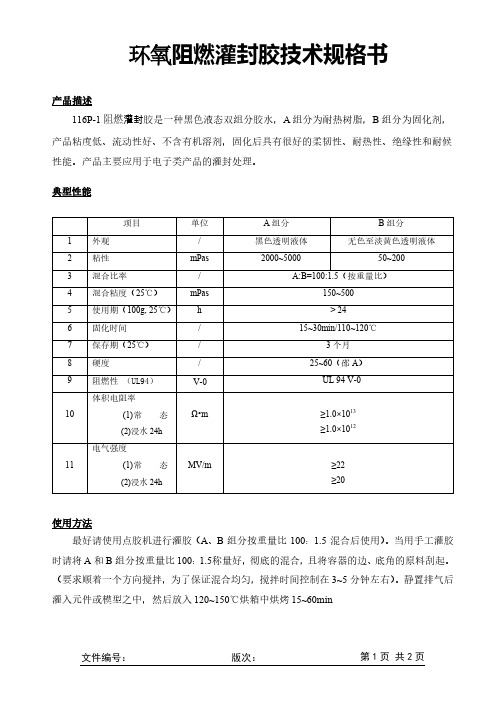
环氧阻燃灌封胶技术规格书产品描述116P-1阻燃灌封胶是一种黑色液态双组分胶水,A组分为耐热树脂,B组分为固化剂,产品粘度低、流动性好、不含有机溶剂,固化后具有很好的柔韧性、耐热性、绝缘性和耐候性能。
产品主要应用于电子类产品的灌封处理。
典型性能项目单位A组分B组分1 外观/ 黑色透明液体无色至淡黄色透明液体2 粘性mPas 2000~500050~2003 混合比率/ A:B=100:1.5(按重量比)4 混合粘度(25℃)mPas 150~5005 使用期(100g, 25℃)h >246 固化时间/ 15~30min/110~120℃7 保存期(25℃)/ 3个月8 硬度/ 25~60(邵A)9 阻燃性 (UL94)V-0UL 94 V-010 体积电阻率(1)常态(2)浸水24hΩ•m≥1.0×1013≥1.0×101211 电气强度(1)常态(2)浸水24hMV/m ≥22≥20使用方法最好请使用点胶机进行灌胶(A、B组分按重量比100:1.5混合后使用)。
当用手工灌胶时请将A和B组分按重量比100:1.5称量好,彻底的混合,且将容器的边、底角的原料刮起。
(要求顺着一个方向搅拌,为了保证混合均匀,搅拌时间控制在3~5分钟左右)。
静置排气后灌入元件或模型之中,然后放入120~150℃烘箱中烘烤15~60min文件编号:版次:第1页共2页注意事项1、胶料应密封贮存。
混合好的胶料应一次用完,避免造成浪费。
2、本品属非危险品,可以按照非危险品保存。
3、B组分存放一段时间后,可能会存在吸潮后变得不透明或表面结皮。
搅拌均匀后可正常使用。
包装及储存说明A组分为20kg或200kg/桶,B组分0.4kg或4kg/桶包装,阴凉干燥下存储,本产品的贮存期为3个月,无装运限制。
文件编号:版次:第2页共2页。
环氧树脂灌封胶操作会遇到的问题?专家说:4个常见问题,如何解决?

环氧树脂灌封胶操作会遇到的问题?专家说:4个常见问题,如何解决?
环氧树脂灌封胶在⼯业⽣产中运⽤的⽐较多,因此经常会遇到各种各样的问题,不⽤担⼼,我
们的⽬标就是解决这些凸显出来的问题,帮助⼤家顺利的操作施胶。
那么环氧树脂灌封胶在操
作的时候有哪些问题需要解决呢?我们⼀起来梳理⼀下!
第⼀个问题:胶⽔没固化或固化慢!
很多⼈在施胶的时候,都会遇到环氧树脂灌封胶胶⽔没有固化或者是固化慢的问题。
这个时候
可能是2点没做到位。
⼀是胶⽔没有放固化剂,或者是固化剂放的⽐例不太对,导致胶⽔固化的
⽐较慢。
⼆是胶⽔的质量不过关或者是胶⽔放的时间太长了,很多成份的功效已经慢慢退化。
所以购买的胶⽔⼀定要在保质期内使⽤,还有要购买⼝碑好、品质有保障的品牌胶粘剂,这样
更放⼼。
第⼆个问题:本来胶⽔固化后应该是硬的,实际却是软的。
这个问题很简单,除开我们前⾯提到的产品质量问题外,还有⼀个就是产品的配⽐问题。
⽐如
固化剂添多了或者是少了等都会影响胶⽔的硬化程度。
第三个问题:有的胶⽔固化了,但是有点胶⽔没固化,什么原因?
可能是没有搅拌均匀,环氧树脂灌封胶在配⽐后⼀定要充分的搅拌均匀。
第四个问题:固化后,胶⽔的表⾯有油污,为什么?
有可能是灌封的过程中,基材的表⾯没有清理⼲净,有⽔、油污或者是灰尘等。
胶⽔的⽐例配⽐不正常也会出现这个问题。
环氧树脂灌封胶在施胶的过程中遇到的这些问题只不过是施⼯环节中的⼀部分问题,还有⼀些问题需要我们在施⼯的过程中不断地去寻找解决的办法,并且记录下来,以便未来再次遇到这些问题的时候可以查找借鉴。
3M Scotchcast双组分环氧阻燃型电缆修复灌封胶Scotchcast 2131 MSDS

Material Safety Data SheetCopyright, 2014, 3M Company All rights reserved. Copying and/or downloading of this information for the purpose of properly utilizing 3M products is allowed provided that: (1) the information is copied in full with no changes unless prior written agreement is obtained from 3M, and (2) neither the copy nor the original is resold or otherwise distributed with the intention of earning a profit thereon.PRODUCT NAME: 3M Scotchcast™Flame-Retardant Compound 2131 (Parts A and B)MANUFACTURER: 3MDIVISION: Electrical Markets DivisionADDRESS: 3M Center, St. Paul, MN 55144-1000, USATelephone:1-888-3M HELPS (1-888-364-3577)Issue Date: 02/19/14Supercedes Date: 11/19/12Document Group: 28-8293-4ID Number(s):80-6114-6812-7, 80-6114-6813-5, 80-6114-6814-3, 80-6114-6815-0, 80-6114-6816-8, 80-6114-6817-6, 80-6114-6818-4, 80-6114-6819-2, 80-6114-6820-0, 80-6114-6821-8, 80-6114-6822-6, 80-6114-6823-4, 80-6114-6824-2, 80-6114-6825-9, 80-6114-6826-7, 80-6114-6874-7,80-6114-6875-4, 80-6114-6876-2, 80-6116-0620-5, 80-6116-0621-3This product is a kit or a multipart product which consists of multiple, independently packaged components. An SDS for each of these components is included. Please do not separate the component SDSs from this cover page. The document numbers of the SDSs for components of this product are:28-7650-6, 28-7666-2Revision Changes:Section 16: Disclaimer (first paragraph) information was modified.Section 16: Disclaimer (second paragraph) information was modified.Kit: Component heading paragraph information was modified.Section 16: Web address information was modified.Section 1: Address information was modified.Copyright information was modified.Telephone header information was modified.Company Telephone information was modified.DISCLAIMER: The information in this Safety Data Sheet (SDS) is believed to be correct as of the date issued. 3M MAKES NO WARRANTIES, EXPRESSED OR IMPLIED, INCLUDING, BUT NOT LIMITED TO, ANY IMPLIED WARRANTY OFMERCHANTABILITY OR FITNESS FOR A PARTICULAR PURPOSE OR COURSE OF PERFORMANCE OR USAGE OF TRADE. User is responsible for determining whether the 3M product is fit for a particular purpose and suitable for user's method of use or application. Given the variety of factors that can affect the use and application of a 3M product, some of which are uniquely within the user's knowledge and control, it is essential that the user evaluate the 3M product to determine whether it is fit for a particular purpose and suitable for user's method of use or application.3M provides information in electronic form as a service to its customers. Due to the remote possibility that electronic transfer may have resulted in errors, omissions or alterations in this information, 3M makes no representations as to its completeness or accuracy. In addition, information obtained from a database may not be as current as the information in the SDS available directly from 3M3M USA SDSs are available at Safety Data SheetCopyright,2014,3M Company.All rights reserved. Copying and/or downloading of this information for the purpose of properly utilizing 3M products is allowed provided that: (1) the information is copied in full with no changes unless prior written agreement is obtained from 3M, and (2) neither the copy nor the original is resold or otherwise distributed with the intention of earning a profit thereon. Document Group:28-7666-2Version Number: 2.00Issue Date:02/19/14Supercedes Date: 06/24/111.1. Product identifier3M™Scotchcast™Flame Retardant Resin 2131 (PART B)Product Identification Numbers80-6114-6841-61.2. Recommended use and restrictions on useRecommended useElectrical, Part B of two part electrical resin1.3. Supplier’s detailsMANUFACTURER: 3MDIVISION: Electrical Markets DivisionADDRESS: 3M Center, St. Paul, MN 55144-1000, USATelephone:1-888-3M HELPS (1-888-364-3577)1.4. Emergency telephone number1-800-364-3577 or (651) 737-6501 (24 hours)2.1. Hazard classificationSerious Eye Damage/Irritation: Category 1.Carcinogenicity: Category 2.2.2. Label elementsSignal wordDangerSymbolsCorrosion | Health Hazard |PictogramsHazard StatementsCauses serious eye damage.Suspected of causing cancer.Precautionary StatementsPrevention:Obtain special instructions before use.Do not handle until all safety precautions have been read and understood.Wear protective gloves and eye/face protection.Response:IF IN EYES: Rinse cautiously with water for several minutes. Remove contact lenses, if present and easy to do. Continue rinsing.Immediately call a POISON CENTER or doctor/physician.IF exposed or concerned: Get medical advice/attention.Storage:Store locked up.Disposal:Dispose of contents/container in accordance with applicable local/regional/national/international regulations. Notes to Physician:Not applicable2.3. Hazards not otherwise classifiedNone.8% of the mixture consists of ingredients of unknown acute oral toxicity.52% of the mixture consists of ingredients of unknown acute dermal toxicity.*The specific chemical identity and/or exact percentage (concentration) of this composition has been withheld as a trade secret.4.1. Description of first aid measuresInhalation:Remove person to fresh air. If you feel unwell, get medical attention.Skin Contact:Wash with soap and water. If signs/symptoms develop, get medical attention.Eye Contact:Immediately flush with large amounts of water for at least 15 minutes. Remove contact lenses if easy to do. Continue rinsing. Immediately get medical attention.If Swallowed:Rinse mouth. If you feel unwell, get medical attention.4.2. Most important symptoms and effects, both acute and delayedSee Section 11.1. Information on toxicological effects.4.3. Indication of any immediate medical attention and special treatment requiredNot applicable5.1. Suitable extinguishing mediaIn case of fire: Use a fire fighting agent suitable for ordinary combustible material such as water or foam to extinguish.5.2. Special hazards arising from the substance or mixtureNone inherent in this product.Hazardous Decomposition or By-ProductsSubstance ConditionCarbon monoxide During CombustionCarbon dioxide During CombustionOxides of Nitrogen During CombustionOxides of Antimony During Combustion5.3. Special protective actions for fire-fightersNo unusual fire or explosion hazards are anticipated.6.1. Personal precautions, protective equipment and emergency proceduresVentilate the area with fresh air. For large spill, or spills in confined spaces, provide mechanical ventilation to disperse or exhaust vapors, in accordance with good industrial hygiene practice. Warning! A motor could be an ignition source and could cause flammable gases or vapors in the spill area to burn or explode. Refer to other sections of this SDS for informationregarding physical and health hazards, respiratory protection, ventilation, and personal protective equipment.6.2. Environmental precautionsAvoid release to the environment. For larger spills, cover drains and build dikes to prevent entry into sewer systems or bodies of water.6.3. Methods and material for containment and cleaning upContain spill. Working from around the edges of the spill inward, cover with bentonite, vermiculite, or commercially available inorganic absorbent material. Mix in sufficient absorbent until it appears dry. Remember, adding an absorbent material does not remove a physical, health, or environmental hazard. Collect as much of the spilled material as possible. Place in a closed container approved for transportation by appropriate authorities. Clean up residue with an appropriatesolvent selected by a qualified and authorized person. Ventilate the area with fresh air. Read and followsafety precautions on the solvent label and SDS. Seal the container. Dispose of collected material as soon as possible.7.1. Precautions for safe handlingDo not handle until all safety precautions have been read and understood. Avoid breathing dust/fume/gas/mist/vapors/spray. Do not get in eyes, on skin, or on clothing. Do not eat, drink or smoke when using this product. Wash thoroughly after handling. Avoid release to the environment. Use personal protective equipment (gloves, respirators, etc.) as required.7.2. Conditions for safe storage including any incompatibilitiesKeep container tightly closed. Keep cool. Store away from heat. Store in a dry place.8.1. Control parameters Occupational exposure limitsAmerican Indust. Hygiene Assoc : American Industrial Hygiene AssociationChemical Manufacturer Rec Guid : Chemical Manufacturer's Recommended GuidelinesUS Dept of Labor -OSHA : United States Department of Labor -Occupational Safety and Health Administration TWA: Time-Weighted-Average STEL: Short Term Exposure Limit CEIL: Ceiling8.2. Exposure controls8.2.1. Engineering controlsUse with appropriate local exhaust ventilation. Provide appropriate local exhaust ventilation on open containers.8.2.2. Personal protective equipment (PPE)Eye/face protectionSelect and use eye/face protection to prevent contact based on the results of an exposure assessment. The following eye/face protection(s) are recommended:Full Face ShieldIndirect Vented GogglesSkin/hand protectionSelect and use gloves and/or protective clothing approved to relevant local standards to prevent skin contact based on the results of an exposure assessment. Selection should be based on use factors such as exposure levels, concentration of the substance or mixture, frequency and duration, physical challenges such as temperature extremes, and other use conditions. Consult with your glove and/or protective clothing manufacturer for selection of appropriate compatible gloves/protective clothing.Gloves made from the following material(s) are recommended: Polymer laminateRespiratory protectionAn exposure assessment may be needed to decide if a respirator is required. If a respirator is needed, use respirators as part of a full respiratory protection program. Based on the results of the exposure assessment, select from the following respirator type(s) to reduce inhalation exposure:Half facepiece or full facepiece air-purifying respirator suitable for organic vapors and particulatesFor questions about suitability for a specific application, consult with your respirator manufacturer.9.1. Information on basic physical and chemical propertiesGeneral Physical Form: LiquidOdor, Color, Grade: Smooth black liquid with pungent odor.Odor threshold No Data AvailablepH Not ApplicableMelting point Not ApplicableBoiling Point> 290 ºFFlash Point> 290 ºF [Test Method: Closed Cup]Evaporation rate No Data AvailableFlammability (solid, gas)Not ApplicableFlammable Limits(LEL)No Data AvailableFlammable Limits(UEL)No Data AvailableVapor Pressure< 27 psia [@ 131 ºF]Vapor Density No Data AvailableDensity No Data AvailableSpecific Gravity 1.29 [Ref Std: WATER=1]Solubility in Water NilSolubility-non-water No Data AvailablePartition coefficient: n-octanol/ water No Data AvailableAutoignition temperature No Data AvailableDecomposition temperature No Data AvailableViscosity5,500 centipoiseVolatile Organic Compounds No Data AvailableVOC Less H2O & Exempt Solvents No Data Available10.1. ReactivityThis material is considered to be non reactive under normal use conditions.10.2. Chemical stabilityStable.10.3. Possibility of hazardous reactionsHazardous polymerization will not occur.10.4. Conditions to avoidNone known.10.5. Incompatible materialsNone known.10.6. Hazardous decomposition productsSubstance ConditionNone known.Refer to section 5.2 for hazardous decomposition products during combustion.The information below may not be consistent with the material classification in Section 2 if specific ingredient classifications are mandated by a competent authority. In addition, toxicological data on ingredients may not be reflected in the material classification and/or the signs and symptoms of exposure, because an ingredient may be present below the threshold for labeling, an ingredient may not be available for exposure, or the data may not be relevant to the material as a whole.11.1. Information on Toxicological effectsSigns and Symptoms of ExposureBased on test data and/or information on the components, this material may produce the following health effects: Inhalation:Respiratory Tract Irritation: Signs/symptoms may include cough, sneezing,nasal discharge, headache, hoarseness, and nose and throat pain.Skin Contact:Contact with the skin during product use is not expected to result in significant irritation.Eye Contact:Corrosive (Eye Burns): Signs/symptoms may include cloudy appearance of the cornea, chemical burns, severe pain, tearing, ulcerations, significantly impaired vision or complete loss of vision.Ingestion:May be harmful if swallowed.Gastrointestinal Irritation: Signs/symptoms may include abdominal pain, stomach upset, nausea, vomiting and diarrhea.Carcinogenicity:Contains a chemical or chemicals which can cause cancer.Toxicological DataIf a component is disclosed in section 3 but does not appear in a table below, either no data are available for that endpoint or the data are not sufficient for classification.Reproductive ToxicityTarget Organ(s)Please contact the address or phone number listed on the first page of the SDS for additional toxicological information on this material and/or its components.Ecotoxicological informationPlease contact the address or phone number listed on the first page of the SDS for additional ecotoxicological information on this material and/or its components.Chemical fate informationPlease contact the address or phone number listed on the first page of the SDS for additional chemical fate information on this material and/or its components.13.1. Disposal methodsDispose of contents/ container in accordance with the local/regional/national/international regulations.Incinerate uncured product in a permitted waste incineration facility. Proper destruction may require the use of additional fuel during incineration processes. As a disposal alternative, utilize an acceptable permitted waste disposal facility. Empty drums/barrels/containers used for transporting and handling hazardous chemicals (chemical substances/mixtures/preparations classified as Hazardous as per applicable regulations) shall be considered, stored, treated & disposed of as hazardous wastes unless otherwise defined by applicable waste regulations. Consult with the respective regulating authorities to determine the available treatment and disposal facilities.EPA Hazardous Waste Number (RCRA): Not regulated15.1. US Federal RegulationsContact 3M for more information.311/312 Hazard Categories:Fire Hazard -No Pressure Hazard -No Reactivity Hazard -No Immediate Hazard -Yes Delayed Hazard -Yes Section 313 Toxic Chemicals subject to the reporting requirements of that section and 40 CFR part 372 (EPCRA): Ingredient C.A.S. No% by WtANTIMONY PENTAOXIDE (ANTIMONY1314-60-9 5 -10COMPOUNDS)15.2. State RegulationsContact 3M for more information.15.3. Chemical InventoriesThe components of this product are in compliance with the chemical notification requirements of TSCA.Contact 3M for more information.15.4. International RegulationsContact 3M for more information.NFPA Hazard ClassificationHealth:2 Flammability:1 Instability:0 Special Hazards:NoneNational Fire Protection Association (NFPA) hazard ratings are designed for use by emergency response personnel to address the hazards that are presented by short-term, acute exposure to a material under conditions of fire, spill, or similar emergencies. Hazard ratings are primarily based on the inherent physical and toxic properties of the material but also includethe toxic properties of combustion or decomposition products that are known to be generated in significant quantities.HMIS Hazard ClassificationHealth:2 Flammability:1 Physical Hazard:0 Personal Protection:X -See PPE section.Hazardous Material Identification System (HMIS® III) hazard ratings are designed to inform employees of chemical hazards in the workplace. These ratings are based on the inherent properties of the material under expected conditions of normal use and are not intended for use in emergency situations. HMIS® III ratings are to be used with a fully implemented HMIS® III program. HMIS® is a registered mark of the American Coatings Association (ACA).Document Group:28-7666-2Version Number: 2.00Issue Date:02/19/14Supercedes Date: 06/24/11DISCLAIMER: The information in this Safety Data Sheet (SDS) is believed to be correct as of the date issued. 3M MAKES NO WARRANTIES, EXPRESSED OR IMPLIED, INCLUDING, BUT NOT LIMITED TO, ANY IMPLIED WARRANTY OF MERCHANTABILITY OR FITNESS FOR A PARTICULAR PURPOSE OR COURSE OF PERFORMANCE OR USAGE OF TRADE. User is responsible for determining whether the 3M product is fit for a particular purpose and suitable for user's method of use or application. Given the variety of factors that can affect the use and application of a 3M product, some of which are uniquely within the user's knowledge and control, it is essential that the user evaluate the 3M product to determine whether it is fit for a particular purpose and suitable for user's method of use or application.3M provides information in electronic form as a service to its customers. Due to the remote possibility that electronic transfer may have resulted in errors, omissions or alterations in this information, 3M makes no representations as to its completeness or accuracy. In addition, information obtained from a database may not be as current as the information in the SDS available directly from 3M3M USA SDSs are available at Safety Data SheetCopyright,2014,3M Company.All rights reserved. Copying and/or downloading of this information for the purpose of properly utilizing 3M products is allowed provided that: (1) the information is copied in full with no changes unless prior written agreement is obtained from 3M, and (2)neither the copy nor the original is resold or otherwise distributed with the intention of earning a profit thereon. Document Group:28-7650-6Version Number: 3.00Issue Date:02/12/14Supercedes Date: 05/09/111.1. Product identifierScotchcast™Flame-Retardant Compound 2131 (Part A)Product Identification Numbers80-6114-6840-81.2. Recommended use and restrictions on useRecommended useElectrical, Part A of two part electrical resin1.3. Supplier’s detailsMANUFACTURER: 3MDIVISION: Electrical Markets DivisionADDRESS: 3M Center, St. Paul, MN 55144-1000, USATelephone:1-888-3M HELPS (1-888-364-3577)1.4. Emergency telephone number1-800-364-3577 or (651) 737-6501 (24 hours)2.1. Hazard classificationAcute Toxicity (inhalation): Category 3.Serious Eye Damage/Irritation: Category 2A.Skin Corrosion/Irritation: Category 2.Respiratory Sensitizer: Category 1.Skin Sensitizer: Category 1.Specific Target Organ Toxicity (respiratory irritation): Category 3.Specific Target Organ Toxicity (repeated exposure): Category 1.2.2. Label elementsSignal wordDangerSymbolsSkull and crossbones | Exclamation mark | Health Hazard |PictogramsHazard StatementsToxic if inhaled.Causes serious eye irritation.Causes skin irritation.May cause allergy or asthma symptoms or breathing difficulties if inhaled.May cause an allergic skin reaction.May cause respiratory irritation.Causes damage to organs through prolonged or repeated exposure:respiratory system |Precautionary StatementsPrevention:Do not breathe dust/fume/gas/mist/vapors/spray.Use only outdoors or in a well-ventilated area.In case of inadequate ventilation wear respiratory protection.Wear eye/face protection.Wear protective gloves.Do not eat, drink or smoke when using this product.Wash thoroughly after handling.Contaminated work clothing must not be allowed out of the workplace.Response:IF INHALED: Remove person to fresh air and keep comfortable for breathing.If experiencing respiratory symptoms: Call a POISON CENTER or doctor/physician.IF IN EYES: Rinse cautiously with water for several minutes. Remove contact lenses, if present and easy to do. Continue rinsing.If eye irritation persists: Get medical advice/attention.IF ON SKIN: Wash with plenty of soap and water.If skin irritation or rash occurs: Get medical advice/attention.Take off contaminated clothing and wash it before reuse.Call a POISON CENTER or doctor/physician if you feel unwell.Storage:Store in a well-ventilated place. Keep container tightly closed.Store locked up.Disposal:Dispose of contents/container in accordance with applicable local/regional/national/international regulations.2.3. Hazards not otherwise classifiedPersons previously sensitized to isocyanates may develop a cross-sensitization reaction to other isocyanates.21% of the mixture consists of ingredients of unknown acute oral toxicity.32% of the mixture consists of ingredients of unknown acute inhalation toxicity.*The specific chemical identity and/or exact percentage (concentration) of this composition has been withheld as a trade secret.4.1. Description of first aid measuresInhalation:Remove person to fresh air. Get medical attention.Skin Contact:Immediately wash with soap and water. Remove contaminated clothing and wash before reuse. If signs/symptoms develop, get medical attention.Eye Contact:Immediately flush with large amounts of water. Remove contact lenses if easy to do. Continue rinsing. Get medical attention.If Swallowed:Rinse mouth. If you feel unwell, get medical attention.4.2. Most important symptoms and effects, both acute and delayedSee Section 11.1. Information on toxicological effects.4.3. Indication of any immediate medical attention and special treatment requiredNot applicable.5.1. Suitable extinguishing mediaIn case of fire: Use a fire fighting agent suitable for ordinary combustible material such as water or foam to extinguish.5.2. Special hazards arising from the substance or mixtureClosed containers exposed to heat from fire may build pressure and explode.Hazardous Decomposition or By-ProductsSubstance ConditionCarbon monoxide During CombustionCarbon dioxide During CombustionHydrogen Cyanide During CombustionOxides of Nitrogen During Combustion5.3. Special protective actions for fire-fightersNo unusual fire or explosion hazards are anticipated.6.1. Personal precautions, protective equipment and emergency proceduresEvacuate area. Ventilate the area with fresh air. For large spill, or spills in confined spaces, provide mechanical ventilation to disperse or exhaust vapors, in accordance with good industrial hygiene practice. Warning! A motor could be an ignition source and could cause flammable gases or vapors in the spill area to burn or explode. Observe precautions from other sections.6.2. Environmental precautionsAvoid release to the environment.6.3. Methods and material for containment and cleaning upContain spill. Pour isocyanate decontaminant solution (90% water, 8% concentrated ammonia, 2% detergent) on spill and allow to react for 10 minutes. Or pour water on spill and allow to react for more than 30 minutes. Cover with absorbent material. Working from around the edges of the spill inward, cover with bentonite, vermiculite, or commercially available inorganic absorbent material. Mix in sufficient absorbent until it appears dry. Remember, adding an absorbent material does not remove a physical, health, or environmental hazard. Collect as much of the spilled material as possible. Place in a container approved for transportation by appropriate authorities, but do not seal the container for 48 hours to avoid pressure build-up. Clean up residue with an appropriate solvent selected by a qualified and authorized person. Ventilate the area with fresh air. Read and follow safety precautions on the solvent label and SDS. Cover, but do not seal for 48 hours. Dispose of collected material as soon as possible.7.1. Precautions for safe handlingFor industrial or professional use only. Do not use in a confined area with minimal air exchange. Do not breathedust/fume/gas/mist/vapors/spray. Do not get in eyes, on skin, or on clothing. Do not eat, drink or smoke when using this product. Wash thoroughly after handling. Contaminated work clothing should not be allowed out of the workplace. Wash contaminated clothing before reuse.7.2. Conditions for safe storage including any incompatibilitiesStore in a well-ventilated place. Keep cool. Keep container tightly closed to prevent contamination with water or air. If contamination is suspected, do not reseal container. Protect from sunlight. Store away from heat. Store away from strong from areas where product may come into contact with food or pharmaceuticals. Store in a dry place.bases.Store awayOccupational exposure limitsAmerican Indust. Hygiene Assoc : American Industrial Hygiene AssociationChemical Manufacturer Rec Guid : Chemical Manufacturer's Recommended GuidelinesUS Dept of Labor -OSHA : United States Department of Labor -Occupational Safety and Health AdministrationTWA: Time-Weighted-AverageSTEL: Short Term Exposure LimitCEIL: Ceiling8.2. Exposure controls8.2.1. Engineering controlsUse general dilution ventilation and/or local exhaust ventilation to control airborne exposures to below relevant Exposure Limits and/or control dust/fume/gas/mist/vapors/spray. If ventilation is not adequate, use respiratory protection equipment. 8.2.2. Personal protective equipment (PPE)Eye/face protectionSelect and use eye/face protection to prevent contact based on the results of an exposure assessment. The following eye/face protection(s) are recommended:Indirect Vented GogglesSkin/hand protectionSelect and use gloves and/or protective clothing approved to relevant local standards to prevent skin contact based on the results of an exposure assessment. Selection should be based on use factors such as exposure levels, concentration of the substance or mixture, frequency and duration, physical challenges such as temperature extremes, and other use conditions. Consult with your glove and/or protective clothing manufacturer for selection of appropriate compatible gloves/protective clothing.Gloves made from the following material(s) are recommended: Butyl RubberFluoroelastomerPolymer laminateIf this product is used in a manner that presents a higher potential for exposure (eg. spraying, high splash potential etc.), then use of protective coveralls may be necessary. Select and use body protection to prevent contact based on the results of an exposure assessment. The following protective clothing material(s) are recommended: Apron –Butyl rubberApron -polymer laminateRespiratory protectionAn exposure assessment may be needed to decide if a respirator is required. If a respirator is needed, use respirators as part of a full respiratory protection program. Based on the results of the exposure assessment, select from the following respirator type(s) to reduce inhalation exposure:Half facepiece or full facepiece air-purifying respirator suitable for organic vapors and particulatesFor questions about suitability for a specific application, consult with your respirator manufacturer.。
2003环氧树脂
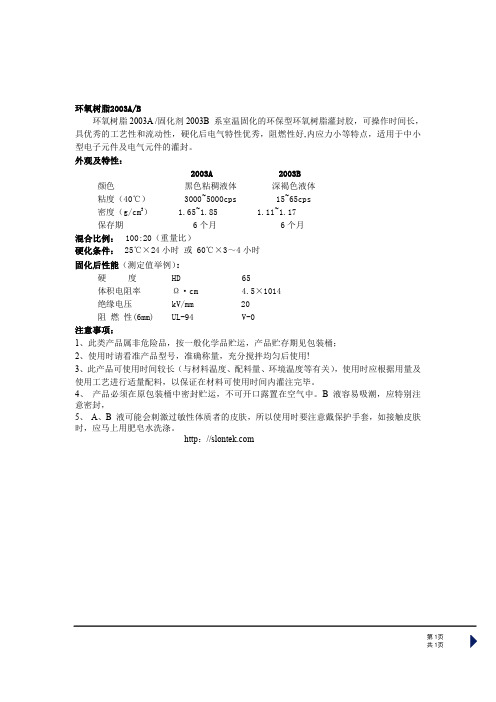
环氧树脂2003A/B
环氧树脂2003A/固化剂2003B系室温固化的环保型环氧树脂灌封胶,可操作时间长,
具优秀的工艺性和流动性,硬化后电气特性优秀,阻燃性好,内应力小等特点,适用于中小
型电子元件及电气元件的灌封。
外观及特性:
2003A2003B
颜色黑色粘稠液体深褐色液体
粘度(40℃)3000~5000cps15~65cps
密度(g/cm3) 1.65~1.85 1.11~1.17
保存期6个月6个月
混合比例:100:20(重量比)
硬化条件:25℃×24小时或60℃×3~4小时
固化后性能(测定值举例):
硬度HD65
体积电阻率Ω·cm 4.5×1014
绝缘电压kV/mm20
阻燃性(6mm)UL-94V-0
注意事项:
1、此类产品属非危险品,按一般化学品贮运,产品贮存期见包装桶;
2、使用时请看准产品型号,准确称量,充分搅拌均匀后使用!
3、此产品可使用时间较长(与材料温度、配料量、环境温度等有关),使用时应根据用量及
使用工艺进行适量配料,以保证在材料可使用时间内灌注完毕。
4、产品必须在原包装桶中密封贮运,不可开口露置在空气中。
B液容易吸潮,应特别注
意密封,
5、A、B液可能会刺激过敏性体质者的皮肤,所以使用时要注意戴保护手套,如接触皮肤
时,应马上用肥皂水洗涤。
http://
第1页
共1页。
环氧树脂胶灌封流程

环氧树脂胶灌封流程下载温馨提示:该文档是我店铺精心编制而成,希望大家下载以后,能够帮助大家解决实际的问题。
文档下载后可定制随意修改,请根据实际需要进行相应的调整和使用,谢谢!并且,本店铺为大家提供各种各样类型的实用资料,如教育随笔、日记赏析、句子摘抄、古诗大全、经典美文、话题作文、工作总结、词语解析、文案摘录、其他资料等等,如想了解不同资料格式和写法,敬请关注! Download tips: This document is carefully compiled by theeditor. I hope that after you download them,they can help yousolve practical problems. The document can be customized andmodified after downloading,please adjust and use it according toactual needs, thank you!In addition, our shop provides you with various types ofpractical materials,such as educational essays, diaryappreciation,sentence excerpts,ancient poems,classic articles,topic composition,work summary,word parsing,copy excerpts,other materials and so on,want to know different data formats andwriting methods,please pay attention!环氧树脂胶灌封的流程可以概括为以下几个关键步骤:准备工作:环境准备:确保工作环境干净,无尘,温度和湿度适宜,因为环氧树脂的固化过程受环境因素影响。
- 1、下载文档前请自行甄别文档内容的完整性,平台不提供额外的编辑、内容补充、找答案等附加服务。
- 2、"仅部分预览"的文档,不可在线预览部分如存在完整性等问题,可反馈申请退款(可完整预览的文档不适用该条件!)。
- 3、如文档侵犯您的权益,请联系客服反馈,我们会尽快为您处理(人工客服工作时间:9:00-18:30)。
应用范围: 本品广泛应用于各类电气浇注,例如变压器、电子元件、电风扇、换风扇、洗衣机,冰箱等, 以及马达驱动用交流电容器,霓虹灯电路,镇流器,电子打火器,潜水泵等的灌封。
技术参数:
外观 密度(g/cm3) 粘度(mpa*s) 混合粘度 混合比
可操作时间 固化时间
重量比
击穿电压 吸水率 冲击强度 弯曲强度 介电常数 硬度 介电损耗 体积电阻 线性收缩率 导热系数 耐温等级 阻燃性
A胶 黑色
物理特性
B胶 浅褐色液体
1.6~1.7
1.00-1.10
10,000
100~400
2000
100
15
20-30 分钟@(25℃,室温) 24 小时(25℃,室温),或者 3 小时(60℃)
技术指标
Kv/mm
15
%
0.05
KJ/m2
>7
MPa
>80
1KHz
4.5
Shore D
>90
1KHz
<0.03
EP12897FR
阻燃环氧树脂电子灌封胶
本品系双组分、环保型阻燃环氧树脂电子灌封胶/密封胶,具有优异的高温特性,广泛应用 于各类电子灌封和电路板保密防护场合。
产品特点: z 双组分树脂浇注系统, 适用于室温固化。 z 含有填料,固化期发热量低(使用前请充分搅拌,防止填料沉淀而无法保证浇注质量)。 z 具有优异的机械性能和电气性能。 z 混合粘度低,自流平,有良好的浇注工艺。 z 耐有机溶剂,吸水率低。 z 对大部分的金属和塑料有良好的粘接力。 z 不含卤素和三氧二锑,为环保产品。 z 耐温等级为 B 级(130℃),达到阻燃 UL94 V0 的要求。
Ω*cm
1E+16
%
0.2
btu/hr/ft2/oF/in.
7 B(130℃)
UL94
V0
深圳市瑞意嘉电子科技有限公司
电话:0755-83408565
网站:
Email: royalcca@gmaห้องสมุดไป่ตู้
